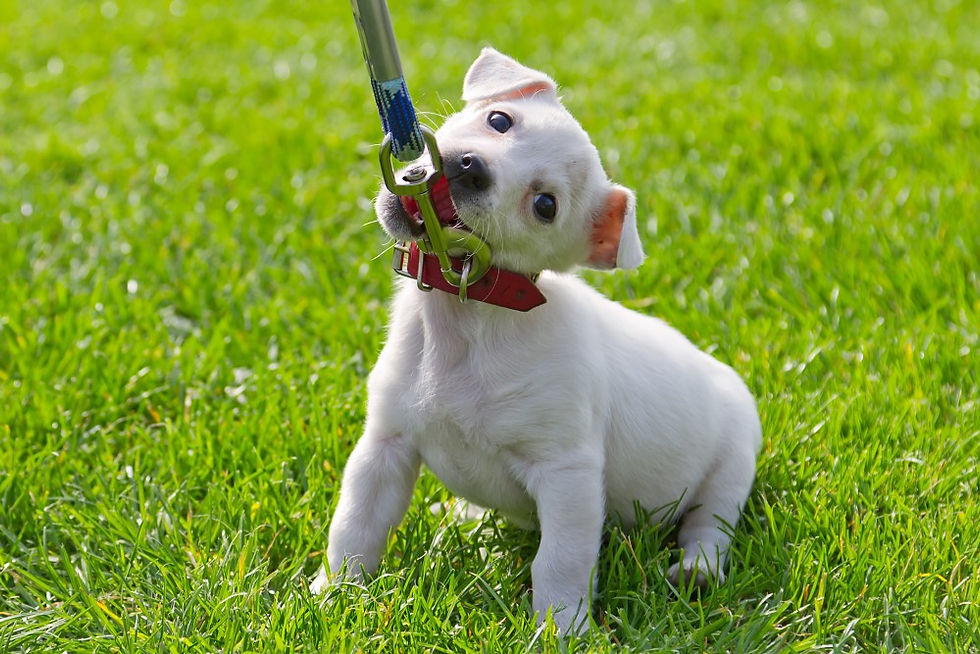Potty Training (Puppies or Dogs)
- Brianna Dick

- Mar 24, 2019
- 4 min read

How to Potty Train your Rescued Dog
No matter if your new dog is a puppy, or an adult, a change in a dog’s environment will require you to reinforce those potty training skills.We present key concepts to follow that will ensure successful training for your new Rescued Dog.
1. Schedule
Be consistent with a feeding and walking schedule! Make sure to take your dog outside after feeding time; the same goes for drinking water. It is important to make sure that your dog actually goes potty when you let him or her out. Once you see that your dog has successfully gone, then allow your dog back inside the house. If your dog is on a consistent feeding/walking schedule, the dog gets accustomed to this and learns when it is acceptable to go potty.
2. Timing
If crate training a dog, it is important to know how long that dog can be left alone without an accident. The same can be said for allowing your dog inside the house. A good rule of thumb is that a 2 month old pup should be able to go accident free for 2 hours, a 4 month old pup 4 hours, etc. For any puppy or adult dog in a new environment, begin with taking the dog out every 2 hours and continually build from there. The maximum time a dog should be expected to hold it is 8-9 hours. Forcing a dog to hold it any longer than this can actually hurt the dog’s bladder. If you see that your puppy is engaging in play (running, tumbling, etc.), take the puppy outside for a potty break. All of that playing typically makes a young dog pee!
3. Crate Training
When your puppy needs to stay home alone, crate training is an invaluable tool that reinforces house training. Because dogs are derived from den-dwelling animals, a crate can become a substitute for a den (i.e. a secure place for your dog to rest). Most dogs will not alleviate themselves where they rest, thus making crate training a perfect way to reinforce house training. To ensure crate training is successful, the size of the crate is crucial. The crate should be only large enough for the dog to stand up and turn around. Any larger, and the dog could alleviate himself in the corner of the crate, and sleep at the other end. Most larger crates come with a divider that allows you to partition the crate, allowing the crate size to grow with the puppy.
4. House Privileges
When beginning to house train your dog, it is important that the dog owner understands that access to the house is a privilege, not a right. Start by letting your new dog into one room, where you can constantly monitor your dog’s behavior. Make sure to close all bedroom doors, etc. Given the chance, your new dog is going to go potty in a room that you are not present in. When a dog has an accident, correcting that behavior (i.e. in a deep voice, “Bad Dog!”) is only meaningful to your dog when you catch your dog in the act. If you do catch your dog having an accident, carry the dog outside immediately and let him or her finish going outside. During the early stages of potty training, look for signs that your dog needs to go to the bathroom. Most dogs will pace, or begin to sniff the floor. If you see either of these behaviors, immediately take your dog outside! Once you can trust that your dog can hold it 2-3 hours, and you are consistent with taking him or her out, allow your dog more access to the house.
5. Positive Reinforcement
Although corrections are important when you catch your dog having an accident, providing your dog with positive reinforcement when your dog relieves itself in the proper area is just as important. Such positive reinforcement can include, in an upbeat voice, “Good for potty!” and a pat on the head. Through this positive reinforcement, one can also train one’s dog to relieve itself on command. This can be very helpful in the mornings when the household is busy trying get out the door. To achieve this, take the dog to the same patch of grass, tree, etc. and while waiting for the dog to relieve itself, give the command “Go Potty!” Once the dog goes potty, give positive reinforcement. Eventually, your dog will be able to go potty on command!
6. Treating Accidents
Accidents will happen. When an accident does happen, make sure that you clean the area with an enzyme cleaner. These cleaners break down the scent molecules, while a regular cleaner will simply mask the scent. Due to scent cues, dogs typically alleviate themselves where they or other dogs have gone before, making it very important to properly clean up an accident. Enzyme cleaners are sold at all major pet stores.
Most importantly, never give a correction for an accident that you did not witness! Dogs cannot associate a correction with an action that occurred in the past. Instead, use positive reinforcement when your dog successfully relieves itself outside. Remember that consistency is key when it comes to potty training!
Fernando Steffey
Founder, Canine Education
https://therescueddog.org/insights-on-potty-training/







Comments